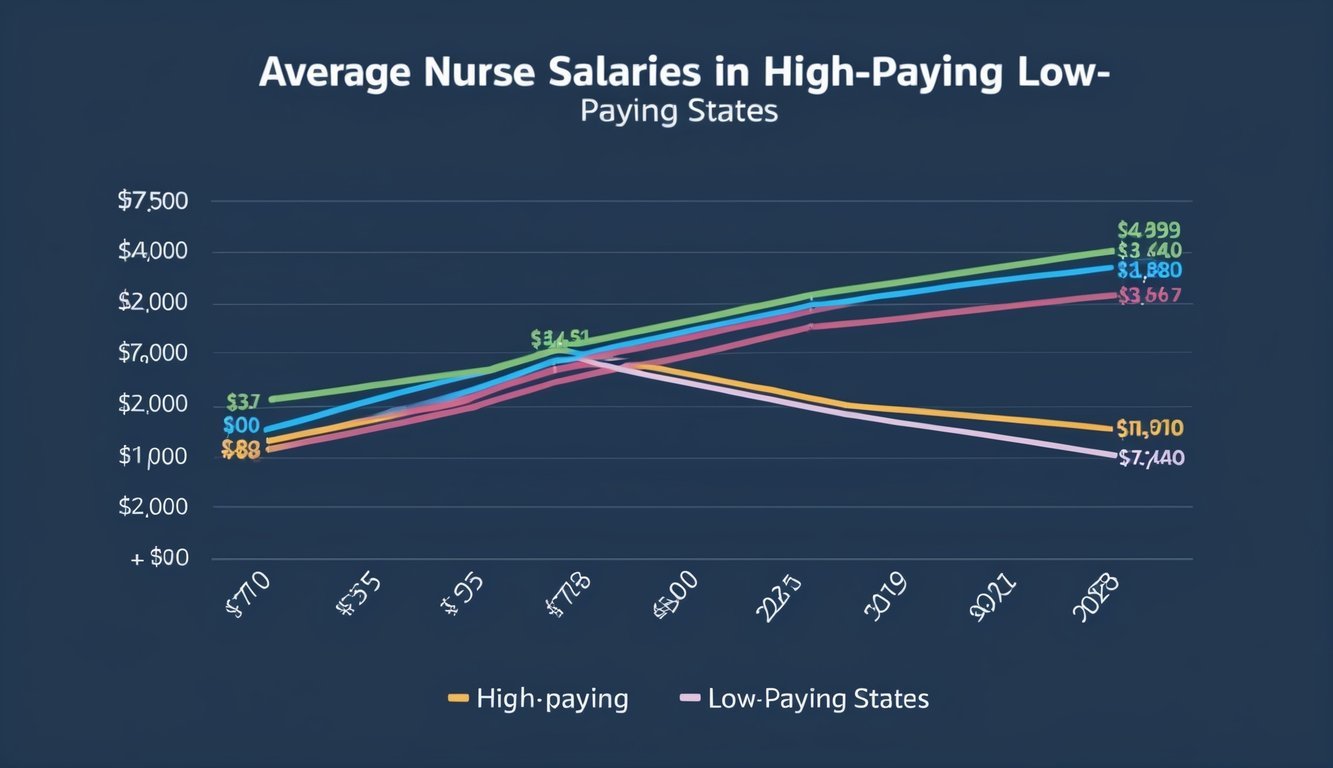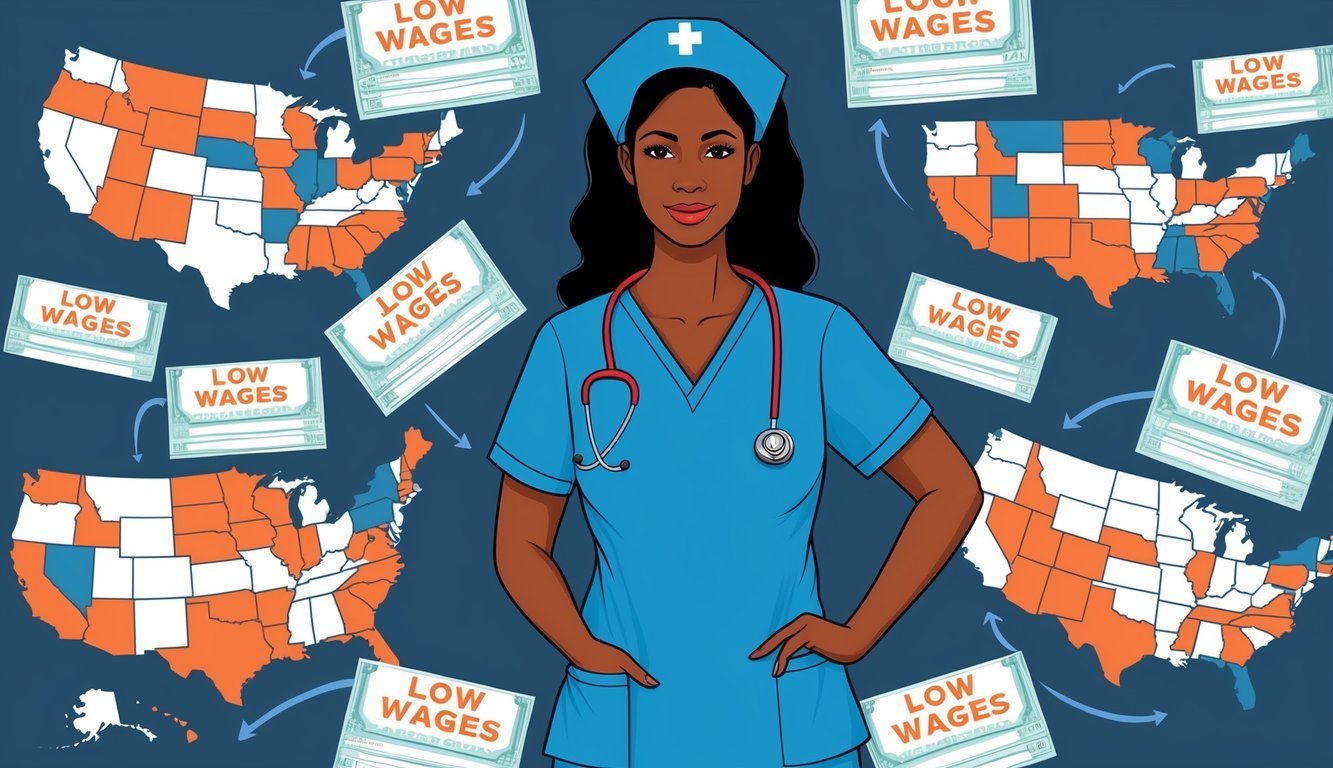Nursing is a vital profession, but not all states offer the same salary for registered nurses.
If you are considering a nursing career or are a current nurse, it’s important to know which states have the lowest paying positions.
Understanding where salaries fall short can help you make informed decisions about your career path and potential relocation.
Some states struggle with lower wages primarily due to their cost of living and demand for healthcare professionals.
Knowing the average salaries across the U.S. can help you assess your options better and discover potential states for higher compensation.
This blog post will explore the bottom states for nursing pay and what those numbers mean for your career.
Every nursing position has its unique factors that influence salaries, including location, experience, and specialty.
By learning about the lowest paying states, you can be better prepared to negotiate salaries or even consider furthering your education for better prospects.
Key Takeaways
- Salaries for nurses vary significantly by state, with some offering much lower pay.
- Understanding factors that drive salary differences can guide your career decisions.
- Considering higher education or relocation can enhance your earning potential in nursing.
Context of Nursing Salaries in the United States
Nursing salaries are influenced by various factors, including geographical location and demand.
Understanding the context of these salaries helps you navigate your career choices and make informed decisions.
Overview of Nurse Salary Metrics
Nurse salaries vary widely depending on several metrics.
These include the type of nurse, location, and experience.
For instance, the average RN salary in the United States is approximately $94,480 per year, translating to about $45.42 per hour.
In contrast, licensed practical nurses (LPNs) and licensed vocational nurses (LVNs) typically earn lower salaries, averaging around $48,070 annually or $23.06 hourly.
Here’s a quick comparison:
| Type of Nurse | Average Annual Salary | Average Hourly Wage |
|---|---|---|
| Registered Nurse (RN) | $94,480 | $45.42 |
| Licensed Practical Nurse | $48,070 | $23.06 |
Geographical factors can also impact salaries significantly.
For example, states like California and Hawaii consistently rank among the highest in terms of pay for nurses, while states like Alabama show lower averages.
The Role of the Bureau of Labor Statistics
The U.S. Bureau of Labor Statistics (BLS) plays a crucial role in providing accurate data on nurse salaries.
The BLS compiles information through its Occupational Employment Statistics program, which tracks employment and wage data across all sectors.
According to the BLS, the national averages are derived from various reports and surveys, ensuring that you get a comprehensive view of the job market.
This data helps job seekers, employers, and policymakers understand trends in nursing salaries.
You can leverage this information to compare salary expectations based on your location or specialty.
For instance, the BLS reports that in 2022, RNs in California earned the highest average salary at $133,990, while those in Alabama earned significantly less, with an average of $60,230.
By utilizing these statistics, you can better assess your potential earnings and choose your career path wisely.
Factors Influencing Nursing Salaries
Nursing salaries can vary widely based on several key factors.
Understanding these elements can help you make informed decisions about your career and where to work as a nurse.
Cost of Living Considerations
The cost of living in different states greatly impacts nursing salaries.
States with a higher cost of living often pay nurses more to match these expenses.
For instance, a nurse in California may earn a higher salary than one in South Dakota, but the cost of everyday items like housing and transportation is also much greater in California.
Here’s a table showing average salaries and cost of living indices for selected states:
| State | Average RN Salary | Cost of Living Index |
|---|---|---|
| California | $120,000 | 149 |
| South Dakota | $59,540 | 89 |
These numbers illustrate how your purchasing power can differ based on where you choose to work.
Educational Level and Specializations
Your educational background and specialization also play significant roles in determining your salary.
Nurses with a Bachelor of Science in Nursing (BSN) typically earn more than those with an Associate’s degree or those working as Licensed Practical Nurses (LPN) or Licensed Vocational Nurses (LVN).
Additionally, specialized roles such as nurse educators can command higher salaries due to the advanced knowledge and skills required.
Here’s a brief look at how different qualifications affect salaries:
| Nursing Role | Average Salary |
|---|---|
| RN with BSN | $94,480 |
| LPN | $48,820 |
| Nurse Educator | $80,000+ |
Higher education and specialization can lead to increased job opportunities and better pay.
Industry and Business Support Services
The industry you work in can significantly influence your salary as a nurse.
Hospitals often pay more compared to clinics or home health agencies due to the additional responsibilities and complexity of care provided.
Business support services also impact nurse salaries through funding and resources.
In regions with strong healthcare support systems, salaries tend to be higher.
Consider these common industries affecting nursing pay:
- Hospitals: Higher pay due to complexity and emergencies.
- Private clinics: Generally lower pay.
- Home health services: Pay varies based on patient needs.
Understanding these factors will help you better navigate your nursing career and make choices that suit your financial needs.
Analysis of Lowest Paying States for Nurses

Many states offer lower salaries for nurses compared to the national average.
Understanding which states fall into this category helps you grasp the financial landscape of the nursing profession.
Identifying States with Lower Nurse Salaries
Several states have consistently ranked among the lowest in nursing pay.
These include Alabama, Mississippi, Arkansas, Iowa, and South Dakota.
While these states provide employment opportunities for nurses, the compensation often does not reflect the workload or skill required.
In South Dakota, you might find salaries around $59,540.
Mississippi and Alabama follow closely behind with approximate salaries of $59,750 and $60,230, respectively.
These figures illustrate the financial challenges nurses face in these regions.
Specific Salary Figures in Identified States
When you look at specific salaries, the differences become clearer.
Here’s a comparison of average annual salaries in the lowest-paying states:
| State | Average Annual Salary |
|---|---|
| Alabama | $60,230 |
| Mississippi | $59,750 |
| Arkansas | $62,000 |
| Iowa | $63,500 |
| South Dakota | $59,540 |
These numbers show quite a stark contrast to higher-paying states.
For example, the median salary for RNs in California can top $133,990.
With such disparities, it’s crucial to consider these salary figures when evaluating job opportunities.
Understanding these numbers can guide your decisions about where to work, especially if you’re concerned about financial stability.
For further details on nursing salaries, check this Nursing Pay by State.
Contrasting High-Paying States

When considering the lowest paying states for nurses, it is important to note the contrast with high-paying states.
The differences in salary can impact career choices and financial stability.
Here are some notable states and how their salaries compare when adjusted for living costs.
Notable High-Salary States for Nurses
Certain states stand out for their high salaries for registered nurses.
These include:
| State | Median Annual Salary |
|---|---|
| California | $133,990 |
| Hawaii | $129,740 |
| Connecticut | $127,800 |
| Alaska | $118,990 |
| Oregon | $113,730 |
California leads the nation with the highest average salary.
This can be attributed to factors such as high demand and a large population.
Similarly, Hawaii offers competitive wages, but the cost of living can offset these earnings.
Connecticut and Alaska also provide attractive salaries, appealing to those seeking higher compensation in less populated areas.
For more details on salaries in nursing, check this resource.
Cost of Living Adjusted Salaries for Comparison
While high salaries are appealing, the cost of living is crucial to evaluate overall financial health.
A high salary in one state may not go as far in terms of expenses.
Here’s a quick comparison:
| State | Median Salary | Cost of Living Index |
|---|---|---|
| California | $133,990 | 149.9 |
| Hawaii | $129,740 | 186.2 |
| Connecticut | $127,800 | 129.6 |
| Alaska | $118,990 | 125.4 |
| Oregon | $113,730 | 115.2 |
In this table, a cost of living index above 100 indicates higher-than-average expenses.
Hawaii has the highest cost, making its salaries less impactful.
Understanding these figures is essential for making an informed decision about where to work.
For further insights, you can explore this resource.
Career Advancement and Mobility

Exploring career advancement opportunities and mobility can significantly impact your journey as a nurse.
You can enhance your skills and possibly increase your salary by considering options like travel nursing and implementing strategies for salary improvements.
Opportunities for Travel Nursing
Travel nursing allows you to work in various locations, providing a unique chance to gain new experiences.
This role often comes with higher pay, which can be especially beneficial if you come from a lower-paying state.
Travel nurses can earn salaries consistently above the average RN salary.
For instance, while the national average for registered nurses might be $86,070, travel nurses in high-demand areas often earn significantly more.
Additionally, working in different environments enhances your skills and networking.
You can build connections with professionals across multiple healthcare systems, leading to potential job offers down the line.
Use platforms like NurseFly to find travel nursing opportunities that suit your goals.
Strategies for Salary Increase
Increasing your salary requires strategic planning.
One effective method is pursuing further education, such as obtaining a Bachelor of Science in Nursing (BSN) or even a Master’s degree.
These degrees can make you eligible for higher-paying positions and advanced practice roles, such as nurse practitioner.
Negotiation is another key strategy.
When considering a new position or renewal of your current contract, don’t hesitate to discuss your worth based on your skills and experience.
Prepare data on average salaries in your region to support your case.
Additionally, seeking certifications in specialized areas like critical care or pediatrics can further boost your earning potential.
Check resources like ANCC for certification opportunities that align with your career goals.
Frequently Asked Questions

In this section, you will find answers to common questions about the salaries of nurses in states where pay is lower.
Understanding these factors can help you navigate your career as a registered nurse.
What are the average salaries for registered nurses in the states with the lowest pay?
Registered nurses in states with the lowest pay often earn below the national average.
South Dakota has been reported as the lowest-paying state, with average salaries around $55,000 per year.
Knowing these figures can help you make informed decisions about where to work.
How does cost of living affect nurses’ salaries in different states?
The cost of living plays a significant role in how far your salary goes.
States with lower living costs, like Mississippi, may have lower nurse salaries.
However, your purchasing power can vary greatly depending on local prices for housing, groceries, and other essentials.
What factors contribute to variations in nurses’ pay across the United States?
Several factors influence pay variation, including demand for nurses, healthcare funding, and the state’s economic situation.
Regions with a higher demand for healthcare often offer better salaries to attract qualified professionals.
Which states are known to offer lower wages to nurses and why?
States like South Dakota, Mississippi, and West Virginia are known for lower wages.
Reasons include a smaller healthcare market, lower demand for nursing staff, and reduced state budgets for healthcare services.
How do nurse salaries compare when adjusted for cost of living in various regions?
When adjusted for cost of living, some states may not appear as low-paying.
For example, while Mississippi has low salaries, the lower cost of living means your earnings might stretch further.
This adjustment helps provide a clearer picture of financial viability in different states.
What are the economic trends influencing registered nurse salaries in lower-paying states?
Economic trends, like healthcare reforms and population shifts, can impact salaries.
Changes in healthcare policy can alter funding and job availability.
This, in turn, affects nurse salaries in those areas.
Keeping an eye on these trends can help you anticipate changes in your salary prospects.

